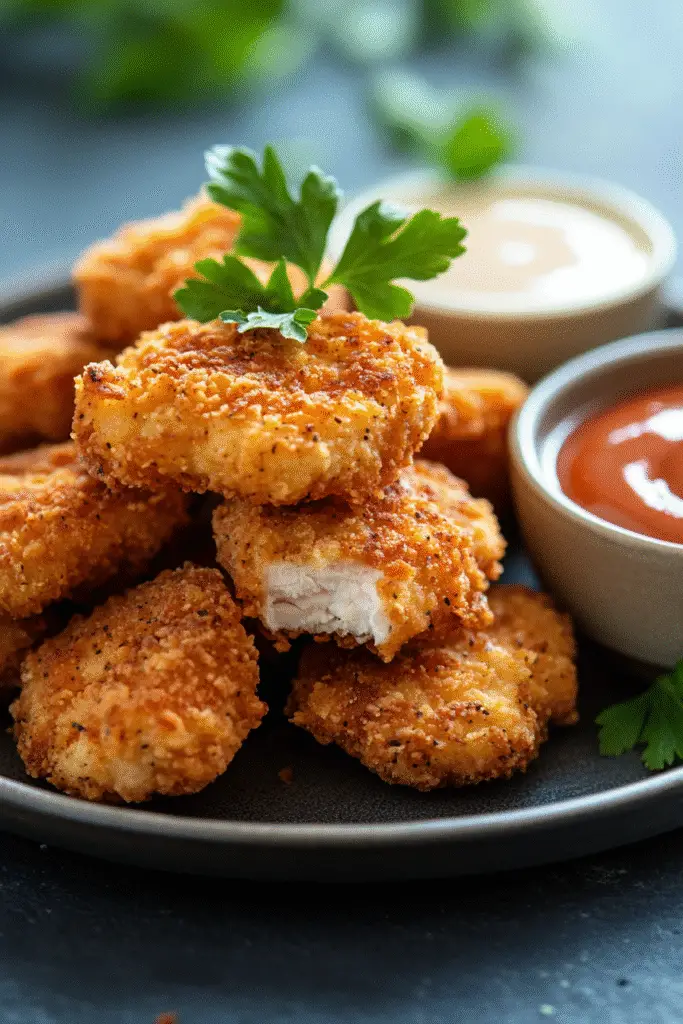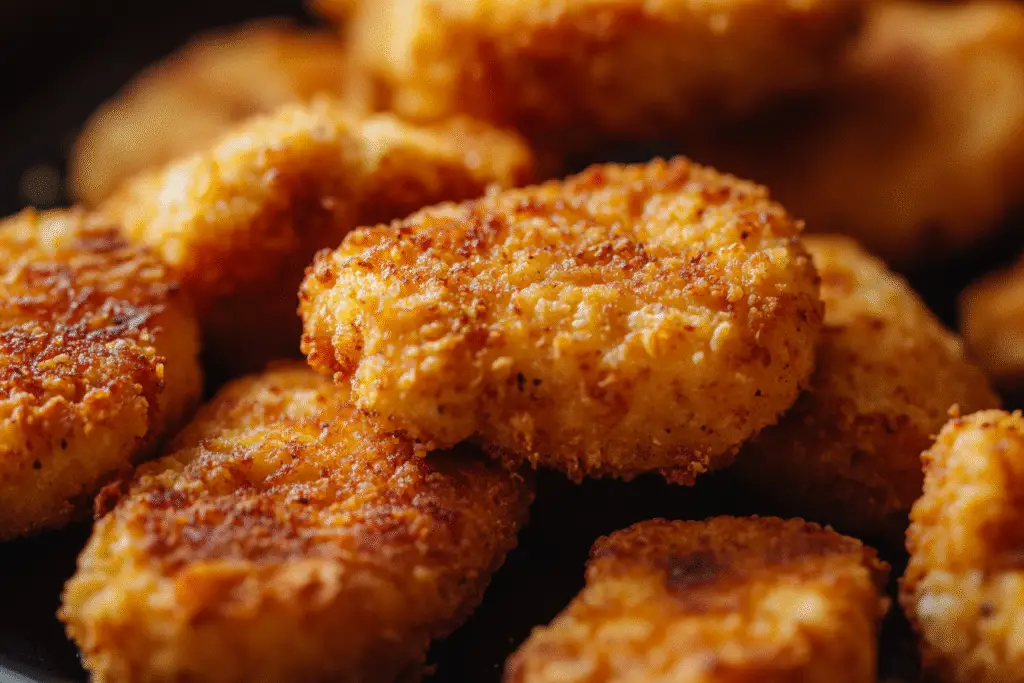Few things are as universally beloved as chicken nuggets. Crispy, golden, and perfectly seasoned, they’re a go-to comfort food that transcends age and culinary background. Whether you’re making them for kids, preparing a party snack, or simply craving a homemade version of the fast-food classic, chicken nuggets are deeply satisfying to create from scratch.
In this detailed guide, we’ll dive into every aspect of crafting the perfect homemade chicken nuggets—from choosing the best chicken cuts to achieving that coveted crispy coating. Along the way, I’ll share practical tips, common mistakes to avoid, ingredient swaps, and flavor variations to help you master this family favorite.
Understanding Chicken Nuggets: The Appeal of Homemade
Homemade chicken nuggets offer something their store-bought or fast-food counterparts can’t: control over the ingredients, the seasoning, and the texture. When you make them yourself, you can ensure they’re free from unnecessary preservatives, choose higher-quality meat, and customize flavors to your liking.
One of the primary differences is texture. Commercial chicken nuggets often use ground or mechanically processed chicken, resulting in a uniform, sometimes overly soft interior. In contrast, homemade versions typically use hand-cut chicken breast or thighs, providing juicy, tender bites with just the right amount of natural texture.
Another advantage? You can play with seasoning in the breading or the marinade and even opt for healthier cooking methods like baking or air-frying if desired.

Choosing the Right Chicken: Breast vs. Thighs
The success of homemade chicken nuggets starts with selecting the appropriate chicken cut. Chicken breast is most commonly used due to its lean, tender quality and familiar texture. It absorbs seasoning well and remains moist when properly cooked.
However, don’t overlook chicken thighs. They offer a richer flavor and are slightly more forgiving in terms of moisture retention, which can be a game-changer if you’re new to frying and concerned about overcooking.
Key tip: Whether you choose breast or thigh, aim for boneless, skinless cuts to simplify preparation and ensure even cooking.
Equipment You’ll Need: Keeping It Simple
The beauty of this recipe is that you don’t need specialized equipment. Here’s what you’ll want to have on hand:
- Sharp chef’s knife (for clean, uniform chicken cuts)
- Three shallow bowls (for the breading station: flour, egg, breadcrumbs)
- Large skillet, Dutch oven, or deep fryer (for frying)
- Tongs or a slotted spoon (for handling the nuggets safely)
- Paper towels and a wire rack (for draining excess oil)
- Optional: kitchen thermometer (to maintain optimal frying temperature)
If you prefer baking or air-frying, a sheet pan and wire rack will work beautifully.
Ingredient Selection and Flavor Additions
When it comes to breading, most homemade chicken nugget recipes rely on flour, egg wash, and breadcrumbs. But you can elevate the flavor significantly by adding seasonings at each layer:
- Flour: Season with salt, pepper, paprika, garlic powder, and onion powder.
- Egg wash: A dash of hot sauce or Dijon mustard adds subtle zing.
- Breadcrumbs: Panko breadcrumbs yield an extra crispy coating, while traditional breadcrumbs provide a tighter, classic crust. You can mix in Parmesan cheese, dried herbs, or even crushed cornflakes for variety.
Pro tip: A touch of cornstarch in the flour mix can boost the crunch factor.

Common Pitfalls and How to Avoid Them
- Overcrowding the pan: This is the fastest way to drop your oil temperature and end up with soggy nuggets. Fry in small batches.
- Skipping seasoning layers: Each layer—flour, egg, breadcrumbs—should carry flavor.
- Oil temperature mismanagement: Aim for 350°F (175°C). Too hot, and the coating burns before the chicken cooks; too cool, and the nuggets absorb excess oil.
- Uneven nugget sizes: Uniformity ensures consistent cooking and prevents some pieces from overcooking while others are underdone.
Preparation Strategies for Success
For smoother cooking, consider these preparation steps:
- Pre-cut your chicken into uniform 1.5-inch pieces.
- Set up your breading station before you begin: flour first, egg wash second, breadcrumbs third.
- Prepare a draining area in advance: a wire rack over paper towels helps prevent sogginess.
- Consider double breading: Dip chicken in flour, then egg, then back into flour, egg, and finally breadcrumbs for an extra thick, crispy crust.
If you want to freeze a batch for later, bread the nuggets, freeze them on a baking sheet until solid, then store in freezer bags. You can fry them straight from frozen—just add a couple of minutes to the cooking time.
Flavor Variations and Dipping Sauces
Chicken nuggets are wonderfully versatile. Try these twists:
- Spicy Nuggets: Add cayenne pepper or chili flakes to the flour mix and hot sauce to the egg wash.
- Herb-Crusted Nuggets: Mix Italian seasoning, oregano, or thyme into the breadcrumbs.
- Cheesy Nuggets: Blend finely grated Parmesan into the breadcrumb mixture for a nutty, savory kick.
Pair them with classic sauces like honey mustard, barbecue, ranch, or even a homemade sweet chili sauce. Each dip can bring out different flavor dimensions of your homemade nuggets.

Ingredient List
For the Chicken Nuggets:
- 1.5 pounds (680 g) boneless, skinless chicken breasts (or thighs)
- 1 cup (125 g) all-purpose flour
- 1 tablespoon cornstarch (optional, for extra crispiness)
- 1 teaspoon salt
- 1/2 teaspoon black pepper
- 1 teaspoon garlic powder
- 1 teaspoon onion powder
- 1 teaspoon paprika
- 2 large eggs
- 2 tablespoons milk
- 1 teaspoon Dijon mustard (optional)
- 2 cups (120 g) panko breadcrumbs (or regular breadcrumbs)
- Vegetable oil for frying (canola, peanut, or sunflower oil work well)
For Serving:
- Dipping sauces: ketchup, honey mustard, barbecue sauce, ranch, sweet chili sauce

Step-By-Step Instructions
1. Prepare the Chicken
Cut the chicken into bite-sized pieces, roughly 1.5 inches in size. Try to keep the sizes uniform for even cooking.
2. Set Up the Breading Station
Arrange three shallow bowls:
- Bowl 1: Mix flour, cornstarch, salt, pepper, garlic powder, onion powder, and paprika.
- Bowl 2: Beat eggs with milk and Dijon mustard (if using).
- Bowl 3: Pour panko breadcrumbs (you can mix in Parmesan, herbs, or spices if desired).
3. Bread the Chicken
Working in batches:
- Dredge chicken pieces in the seasoned flour, shaking off excess.
- Dip them into the egg mixture, ensuring each piece is fully coated.
- Roll them in the breadcrumbs, pressing gently to adhere.
For a thicker crust, repeat the flour and egg steps before the final breadcrumb coating.
4. Heat the Oil
Pour oil into a deep skillet or Dutch oven to a depth of about 1.5 inches. Heat to 350°F (175°C). Use a kitchen thermometer to monitor the temperature consistently.
5. Fry the Nuggets
Fry chicken in batches, being careful not to overcrowd the pan. Cook for 3–4 minutes per side, or until golden brown and crispy. The internal temperature should reach 165°F (74°C).
Transfer fried nuggets to a wire rack set over paper towels to drain.
6. Serve
Serve hot with your choice of dipping sauces.
Troubleshooting and FAQs
Why are my chicken nuggets soggy?
Most likely, the oil temperature was too low, or the nuggets sat on paper towels instead of a wire rack, trapping steam.
Can I bake these instead?
Yes! Preheat oven to 425°F (220°C), place nuggets on a wire rack set over a baking sheet, spray with cooking oil, and bake for 20–25 minutes, flipping halfway through.
How do I store leftovers?
Store cooled nuggets in an airtight container in the refrigerator for up to 3 days. Reheat in a 400°F (200°C) oven or air fryer until crisp.
Can I freeze them?
Absolutely. Freeze breaded, uncooked nuggets on a baking sheet, then transfer to a freezer bag. Fry from frozen, adding a few extra minutes to the cooking time.
Variations: Nugget, Tender, or Strip?
Chicken Nuggets: Small, bite-sized pieces with a thick, even coating.
Chicken Tenders: Long strips of chicken breast, often with a thinner breading.
Chicken Strips: Similar to tenders but typically cut from larger breast pieces, often with a craggier, crunchier coating.
Nuggets offer the best ratio of crust to meat and are ideal for dipping and snacking. Tenders and strips make excellent entrees or sandwich fillings.
Final Thoughts
Homemade chicken nuggets deliver everything we love about the fast-food classic but with fresher, customizable flavors and a satisfying crunch you can control. Whether you go for the classic version, spice them up, or experiment with different breadings and dips, this is a recipe you’ll come back to time and time again. Plus, once you see how easy they are to make, you might never reach for the frozen version again.
Let me know how your batch turns out, and feel free to share your favorite dipping sauce combinations!
